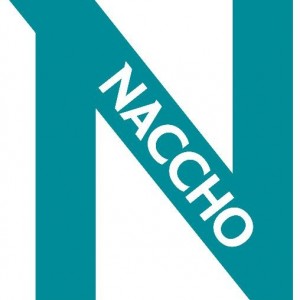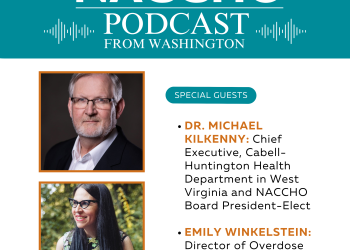By Kevin Cevasco, MBA, NACCHO Intern
The Trust for Public Land (TPL), in partnership with NACCHO, is identifying ways to introduce place-based arts practices within county and city public health agencies. This practice is referred to as creative placemaking, and it involves public, private, non-profit, and community sectors partnering up to strategically shape the physical and social character of a neighborhood, town, tribe, city, or region around arts and cultural activities.
The “Creative Parks, Healthy Communities” (CPHC) project will focus on a) delivering actionable policy and programming recommendations to improve a community’s outdoor environment and b) supporting engaged and informed communities, with the intention of improving overall health. The project kicked off at NACCHO Annual 2019 and will conclude at NACCHO 2020 with the release of a toolkit to scale this practice across the country.
Achieving Health Equity through Creative Placemaking
The ultimate goal of the project is to support the achievement of health equity across all communities in America. This goal acknowledges the structural inequities present in the distribution of resources and power in this country. Similarly, the project recognizes that to redress this history, communities need strong assets to build equitable places, as well as social capital and collective efficacy to overcome the systems historically contributing to health inequity.
The past decade has seen robust research on ecological models of health, place-based outcomes, and the connection between arts and culture, the outdoors, and health. Economic improvements are not the only important factor for improving health outcomes of a neighborhood; local creative places and organizations play a big role.
Central to moving America towards health equity is building healthier communities. Research shows that citizens that participate in neighborhood organizations report significantly better health. The growing body of evidence shows that health outcomes are determined by strong, culturally resilient communities. As such, CPHC is developing strategies to leverage the arts and culture’s role as a driver of community health.
Origins of Creative Placemaking
Land use planning and concern for the built environment originated from a public health focus in the nineteenth century when overcrowding, factory pollution, and poor sanitation led to infectious diseases being the major cause of death in the Unites States. The new challenge is chronic disease prevention because nearly 80% of the 10,000 people who turn 65 each day have at least one chronic health condition, and most have multiple chronic conditions. Creative placemaking enables local health departments (LHD) to address the modern challenge of chronic disease prevention and management through place-based community engagement.
Improving Health Outcomes through Arts & Cultural Expression and Parks & Green Space
This project focuses on two determinants that, based on evidence and research, have strong impacts on health outcomes at an individual and population level: art and cultural expression, and parks and green space. Arts and culture can mend collective trauma, improve social isolation and exclusion, address mental health, and reduce certain chronic diseases. The presence of parks and green space also has a demonstrated impact on mental health, social isolation and exclusion, and chronic disease, not to mention the benefits of reducing heat islands and stormwater runoff.
Both arts and culture and parks and greens space help fulfill capacities and benefits that go beyond direct exposure. Arts and culture can shift perspectives and elevate meaningfulness to improve health communication, advance community-generated health perspectives, and organize stakeholders. Similarly, parks and green spaces provide a foundation for community advocacy and decision making, promote healthy activities and exposures, and provide a shared public amenity. These capacities support not only immediate health benefits, but also long-term structural change towards health equity.
Creative Placemaking in Action: South Wenatchee, WA
Cherry Fest, a celebration marking the end of the cherry season was held on Thursday evening at Kiwanis Methow Park. The celebration was put on by the parque padrinos, or godparents of the park, a group that has started daily community events in the park.
One example of the impact of creative places comes from South Wenatchee, a community of predominantly Latino immigrants connected to the apple orchards of mid-Washington state. Kiwanis-Methow Park is a small neighborhood park that serves this community, which has suffered over the past decade from higher than average mental health issues, lower civic participation, and deeper social isolation, according to a health impact assessment in 2013.
In 2013, TPL, with community partners, began a process of renovating this park and started to undertake traditional engagement methods, such a holding meetings, which proved unsuccessful. However, when these organizations began to work with local artist leaders and sponsor culturally relevant activities, they overcome the historic distrust in the Latino community. These new activities generated positive engagement and allowed other non-profits to connect with South Wenatchee around job access and health practices.
Through this multi-year outreach process that started as a park renovation, a new group of civic activists initiated by Wenatchee residents called Parque Padrinos has taken up the mantle not only to steward the park, but also to organize and mobilize Latino residents. This mobilization has resulted in greater participation in civic matters and substantially increased the voter turnout of Latinos.
Matthew Clarke, Director of Creative Places at TPL, says, “We do not build just parks, we build trust.” When the process of creating public art engages people in the neighborhood in a sensitive and genuine manner, it can be profoundly transformative and improve the health of a community. TPL believes the most empowering public art comes from envisioning by the community itself.
A Toolkit for Local Health Departments
According to NACCHO’s 2016 National Profile of Local Health Departments, 76% of LHDs are already working with their local parks and recreation departments. There is an opportunity for LHDS to further engage with parks and recreation departments and introduce creative placemaking into these partnerships. The results of the CPHC project will be disseminated through a toolkit with policy, case study, and implementation material for LHDs. The toolkit will be available at www.naccho.org in July 2020.



